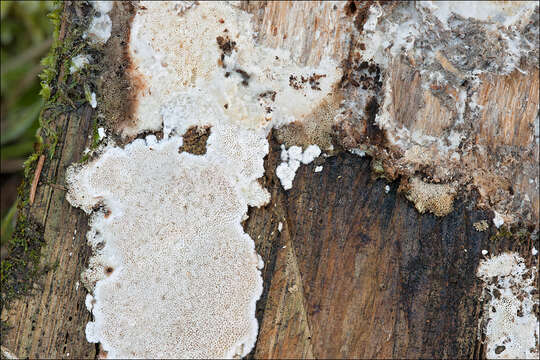Cinereomyces-lindbladii_2

Descrição:
Cinereomyces lindbladii (Berk.) Jl., syn.: Diplomitoporus lindbladii (Berk.) Gilb. & Ryv., Polyporus lindbladii Berk., Poria cinerasceus Sacc. & Syd., Antrodia lindbladii (Berk.) Ryv.DE: Grauschillernder ResupinatporlingSlo.: jelkin sivolukniarDat.: Jan.13. 2016Lat.: 46.37004 Long.: 13.72908Code: Bot_928/2016_DSC0102Habitat: mixed wood, close to a river, at the foot of steep mountain; northwest aspect; calcareous, colluvial ground; in shade, high air humidity; partly protected from direct rain by tree canopies; average precipitations ~ 3.000 mm/year, average temperature 6-8 deg C, elevation 570 m (1.870 feet), alpine phytogeographical region.Substratum: Rotten, Picea abies pole (formerly a part of wooden fence around a small pasture) lying on a large Picea abies stump; underside of the pole (resupinate form) and the gap between the pole and Picea abies stump (cottony-fibrous form).Place: Lower Trenta valley, left bank of river Soa, next to 'Soka pot' (Soa river trail), somewhat downstream of farmhouse Maselc, East Julian Alps, Posoje, Slovenia EC. Comments: Growing in two forms, resupinate, poroid (underside of the pole hanging in the air) and cottony-fibrous (in-between the pole and the tree stump); dimensions of the resupinate part about 3.5 x 25 cm, dimension of cottony part 10 x 40 cm; pore layer up to 5 mm thick; about 3 pores/mm; subiculum very thin, almost none, less than 0.5 mm thick; sporocarps quite firm (photographed in half frozen state - air temperature was below zero C), hard when dry; pore surface of old and dry sporocarps gray with an interesting shimmer when looked at changing angle like a kind of interference pattern (German name of the species!); smell none (low temperatures? should be unpleasant according to literature); taste mild but distinctive, on resin, chemicals? 5% KOH reaction on pore surface mild, pale ocher-yellow; SP faint, oac color could not be determined. Accidentally small creatures living in the fungus were observed (Figs. ). Does anybody know what could they be?Spores smooth, cylindrical-allantoid with (mostly) two oil drops. Dimensions: 5.5 [6 ; 6.2] 6.6 x 1.9 [2.2 ; 2.4] 2.7 microns; Q = 2.2 [2.6 ; 2.7] 3.1; N = 30; C = 95%; Me = 6.1 x 2.3 microns; Qe = 2.6. Basidia dimensions: 11.2 [13.7 ; 17.2] 19.8 x 4.3 [4.5 ; 4.7] 4.9 microns; Q = 2.4 [3 ; 3.7] 4.3; N = 6; C = 95%; Me = 15.5 x 4.6 microns (according to Ryvarden (2014) 10-20 x 4.5-5.5 microns). Tramal hyphae thick walled, not septated, generative hyphae with clamps not seen. Olympus CH20, NEA 100x/1.25, magnification 1.000 x, oil (spores); NEA 40x/0.65, magnification 400x (hyphae, hymenium, others), in water, in vivo. AmScope MA500 digital camera.Herbarium: Mycotheca and lichen herbarium (LJU-Li) of Slovenian Forestry Institute, Vena pot 2, Ljubljana, Index Herbariorum LJFRef.:(1) J. Breitenbach, F. Kraenzlin, Eds., Fungi of Switzerland, Vol.2. Verlag Mykologia (1986), p 280. (2) G.J. Krieglsteiner (Hrsg.), Die Grosspilze Baden-Wrttembergs, Band 1, Ulmer (2000), p 515. (3) L. Ryvarden, R.L. Gilbertson, European Polypores, part 1., Synopsis Fungorum 7., Fungiflora A/S (1993), p 246. (4) A. Bernicchia, Polyporaceaes l., Fungi Europaei, Vol. 10., Edizioni Candusso (2005), p 206. (5) S. Buczacki, Collins Fungi Guide, Collins (2012), p 498. (6) L. Hagar, Ottova Encyklopedia Hb, Ottova Nakladatelstvi, Praha (2015) (in Slovakian), p 329.(7) L. Ryvarden, I. Melo, Poroid fungi of Europe, Synopsis Fungorum 31., Fungiflora (2014), p 152.
Incluído nas seguintes páginas:
- Life
- Cellular
- Eukaryota (Eucariontes)
- Opisthokonta
- Nucletmycea
- Fungi
- Dikarya
- Basidiomycota
- Agaricomycetes
- Polyporales
- Polyporaceae
- Cinereomyces
- Cinereomyces lindbladii
Esta imagem não aparece em nenhuma coleção.
Informação de origem
- licença
- cc-by-nc-sa
- direitos autorais
- Amadej Trnkoczy
- fotógrafo
- Amadej Trnkoczy
- original
- arquivo de mídia original
- visite a fonte
- site do parceiro
- Flickr Group
- ID


